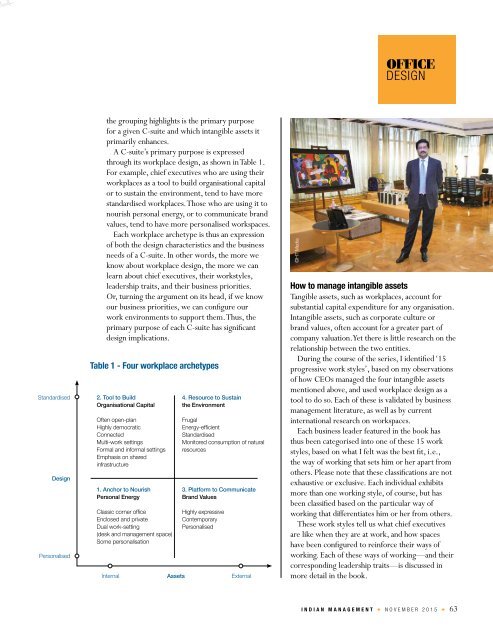the new hr
1NT8tPl
1NT8tPl
You also want an ePaper? Increase the reach of your titles
YUMPU automatically turns print PDFs into web optimized ePapers that Google loves.
office<br />
design<br />
Standardised<br />
Design<br />
Personalised<br />
<strong>the</strong> grouping highlights is <strong>the</strong> primary purpose<br />
for a given C-suite and which intangible assets it<br />
primarily enhances.<br />
A C-suite’s primary purpose is expressed<br />
t<strong>hr</strong>ough its workplace design, as shown in Table 1.<br />
For example, chief executives who are using <strong>the</strong>ir<br />
workplaces as a tool to build organisational capital<br />
or to sustain <strong>the</strong> environment, tend to have more<br />
standardised workplaces. Those who are using it to<br />
nourish personal energy, or to communicate brand<br />
values, tend to have more personalised workspaces.<br />
Each workplace archetype is thus an expression<br />
of both <strong>the</strong> design characteristics and <strong>the</strong> business<br />
needs of a C-suite. In o<strong>the</strong>r words, <strong>the</strong> more we<br />
know about workplace design, <strong>the</strong> more we can<br />
learn about chief executives, <strong>the</strong>ir workstyles,<br />
leadership traits, and <strong>the</strong>ir business priorities.<br />
Or, turning <strong>the</strong> argument on its head, if we know<br />
our business priorities, we can configure our<br />
work environments to support <strong>the</strong>m. Thus, <strong>the</strong><br />
primary purpose of each C-suite has significant<br />
design implications.<br />
Table 1 - Four workplace archetypes<br />
2. Tool to Build<br />
Organisational Capital<br />
Often open-plan<br />
Highly democratic<br />
Connected<br />
Multi-work settings<br />
Formal and informal settings<br />
Emphasis on shared<br />
infrastructure<br />
1. Anchor to Nourish<br />
Personal Energy<br />
Classic corner office<br />
Enclosed and private<br />
Dual work-setting<br />
(desk and management space)<br />
Some personalisation<br />
4. Resource to Sustain<br />
<strong>the</strong> Environment<br />
Frugal<br />
Energy-efficient<br />
Standardised<br />
Monitored consumption of natural<br />
resources<br />
3. Platform to Communicate<br />
Brand Values<br />
Highly expressive<br />
Contemporary<br />
Personalised<br />
Internal Assets External<br />
©HT Media<br />
How to manage intangible assets<br />
Tangible assets, such as workplaces, account for<br />
substantial capital expenditure for any organisation.<br />
Intangible assets, such as corporate culture or<br />
brand values, often account for a greater part of<br />
company valuation. Yet <strong>the</strong>re is little research on <strong>the</strong><br />
relationship between <strong>the</strong> two entities.<br />
During <strong>the</strong> course of <strong>the</strong> series, I identified ‘15<br />
progressive work styles’, based on my observations<br />
of how CEOs managed <strong>the</strong> four intangible assets<br />
mentioned above, and used workplace design as a<br />
tool to do so. Each of <strong>the</strong>se is validated by business<br />
management literature, as well as by current<br />
international research on workspaces.<br />
Each business leader featured in <strong>the</strong> book has<br />
thus been categorised into one of <strong>the</strong>se 15 work<br />
styles, based on what I felt was <strong>the</strong> best fit, i.e.,<br />
<strong>the</strong> way of working that sets him or her apart from<br />
o<strong>the</strong>rs. Please note that <strong>the</strong>se classifications are not<br />
exhaustive or exclusive. Each individual exhibits<br />
more than one working style, of course, but has<br />
been classified based on <strong>the</strong> particular way of<br />
working that differentiates him or her from o<strong>the</strong>rs.<br />
These work styles tell us what chief executives<br />
are like when <strong>the</strong>y are at work, and how spaces<br />
have been configured to reinforce <strong>the</strong>ir ways of<br />
working. Each of <strong>the</strong>se ways of working—and <strong>the</strong>ir<br />
corresponding leadership traits—is discussed in<br />
more detail in <strong>the</strong> book.<br />
I NDIAN MANAGEMENT NOVEMBER 2015 63


